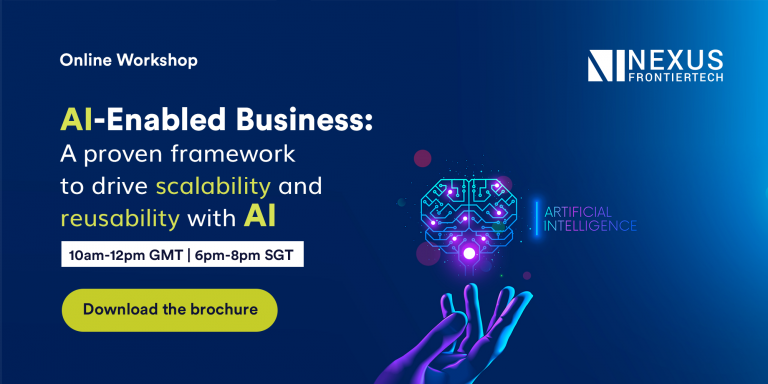

According to a study by IDC, global investments on AI systems are projected to reach $97.9 billion by 2023, and data analytics firm Teradata predicts that roughly 80% of modern businesses have implemented AI in some way to their business processes. However, 90% of these businesses still face significant challenges in implementing AI-projects.
In this blog we break down the problems facing most modern-day companies into 4 major groups:
Difficulty assessing business cases
You must have a very clear idea of the business problems you are looking to solve with the introduction of AI solutions. Identifying business cases requires managers to have an understanding of current AI technologies, their capabilities and limitations, and the processes and workflows in their departments. (*It’s important to note that you do not need to have a technical background or an in-depth knowledge of AI technologies to be able to identify business cases. We explain why in a previous blog.)
One of the major issues executives face has less to do with the technical feasibility of their AI models, but with the long-terms affects that these AI models have (or don’t have) on their business. To best reap the benefits of AI, companies need to identify cases that will allow their AI solution to scale across departments/the organisation. In other words, it should be reusable. Implementing a new system with a short-sighted plan will only lead to short-term benefits.
Lack of vision
Implementing AI requires a strategy approach which includes setting objectives, identifying KPIs, measuring results and tracking ROI. Oftentimes leaders jump on the AI bandwagon without a clear vision and strategy put in place, putting their hopes into the hyper-optimistic idea sold by many third party vendors that the integration of an AI solution will solve all their problems.
Remember, you must be realistic with your views of AI’s impact and strategise with a measurable, narrow goal in mind, and be clear on the impact it will have on your business both short and long term.
Lack of budget
AI isn’t cheap, and if we take tech giants out of the picture, AI tends to be pretty pricey and makes it difficult for many businesses to take the plunge. However, AI is becoming more and more accessible to smaller and medium-sized companies. One way to test the viability of AI in your business is by starting small. Starting with one AI project that tackles a very narrow problem in one of your processes allows you to control your spend and see how well the solution works. If successful, these solutions can oftentimes be scaled across other parts of your business or open the door for new budget approvals from your board.
Difficulty choosing a vendor
With the influx of AI companies in recent years, your head may be spinning at the prospect of choosing the best one to partner with if you don’t have an in-house team of data scientists. A large number of vendors exaggerate their experience and successes, making unrealistic claims about the results their solutions can get you. In fact, many of them may not even know how to effectively use AI to solve real business problems.
Do your research. It’s a good idea to shortlist a number of vendors and attend some of their events, webinars or workshops to get a feel of their approach to working with enterprise. Most companies will offer case studies, demos and assessments for free via their website or social media channels. We have a dedicated area on our own website for the community to download resources such as whitepapers and case studies.
Data quantity
Data is the fuel that AI needs to run and its power and effectiveness depends largely on the amount of data it receives and learns from. AI systems require large datasets in order for the technology to identify patterns, and organisations must have a constant source of data to keep it up and running. Identify the data you already have and compare that to what data is still needed. If you are missing important data points you may be able to purchase data from third parties.
Data quality
Now, although having massive training datasets is important, it’s important that the data that the machine learning models are being fed are relevant and useful. It is challenging for organisations to integrate data since information is usually spread across multiple applications in various formats like text, image, video, and audio. AI success will depend on quality data to build models and provide accurate learning and results. Overall, it is better to train models with a smaller dataset that is highly accurate than a massive one with irrelevant or poor quality data.
Since data is the lifeblood of any organisation’s AI transformation initiatives, it’s important to get this part right. In our experience, most executives we work are well aware of the positive impact AI can have on their business, but don’t know how to actually make it work. A large part of this is due to lack of strategy that generates data that brings about real value, and knowing how to harvest this data.
If you’re interested in learning more about how to leverage data to achieve your business goals, check out our workshop.

Lack of IT infrastructure
Data handling, computing, storage, scaling and security are all critical for enterprises to have a successful AI solution deployed. Machine learning and deep learning require state of the art infrastructure that has sufficient processing capabilities and high-speed storage. There is also a need for the right software that is optimised to work with the hardware, and a flexible infrastructure that can be deployed in the cloud or into an on-premise data center.
Integration challenges
Creating highly-optimised AI models is one thing, but getting those models to integrate with your existing IT environment and business workflows is another. Because there is no universal out-of-the-box enterprise AI solution, integrating this technology into your existing systems is far more complicated than a simple plug-and-play.
Whether you’re working with an in-house team or a vendor, everyone will have to have a clear understanding of the processes involved. If working with a vendor, this will most likely require that vendor to have a broader expertise, not just building models. Someone with an expertise in bridging the tech and business/operational needs will be needed.
Lack of talent
In order to develop a successful AI solution, you need experts with both technical knowledge and business knowledge. This is not the case in most enterprises. Managers typically lack the tech know-how they need to strategise and kickstart an AI project, while data scientists aren’t considering how their models will be used in a real business context.
There is also a scarcity of data scientists available in relation to demand. Companies outside of the FAGMA group (Facebook, Amazon, Google, Microsoft, Apple) struggle to acquire top talent and even if they do, they are struggling to retain them.
If hiring these experts and building an in-house team is out of the question for your business, outsourcing is a viable option.
Lack of AI understanding & buy-in
Unfortunately, AI is still highly mystified and few have insight into the real capabilities and limitations of it. From believing an in-house data science team needs to be hired to to the idea that robots will soon be taking over everyone’s jobs, both managers and their teams are oftentimes misled and misinformed when it comes to what AI means for them and their business.
Education is key. Begin by signing up for webinars or workshops that give insight to AI and its uses in your industry. Reach out to experts in the field and ask them to share their knowledge and experience with you. Read up on use cases and other resources available to you. Arming yourself and your team with this information will help both manage your expectations and put minds at ease if a real value is identified.
If you’re struggling with any of the problems listed above, feel free to check out AI-Enabled Business: A proven framework to drive scalability and reusability. In this 2 hour interactive workshop you and your peers will learn from industry experts how to use the “Data Loop” method to take your business processes to the next level of productivity.
Level 39, One Canada Square,
Canary Wharf, London
E14 5AB
6 Battery Rd, #03-68,
The Work Project @ Six Battery Road
Singapore 049909
Studio 1006, Dreamplex Thai Ha, 10th floor 174 Thai Ha Str, Dong Da Dist
Hanoi 100000, Vietnam
Remote Teams
